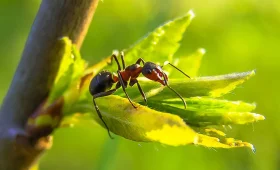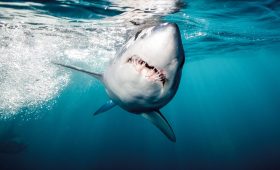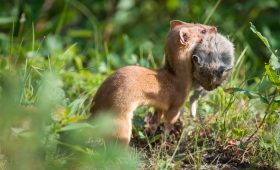memme.info – The polar bear, a powerful and majestic creature, stands as one of the most iconic animals of the Arctic. Known for its large size, white fur, and remarkable adaptations to cold environments, the polar bear is an emblem of the frozen north. However, despite its dominance in the Arctic ecosystem, the polar bear faces significant challenges due to the rapidly changing climate. This article explores the polar bear’s physical characteristics, behavior, habitat, and the urgent conservation efforts needed to protect this magnificent species.
Physical Characteristics
Polar bears are the largest land carnivores, with adult males weighing between 900 and 1,600 pounds (410 to 720 kilograms) and standing up to 10 feet (3 meters) tall on their hind legs. Females are generally smaller, weighing between 330 and 550 pounds (150 to 250 kilograms). Their large size is an adaptation to help them conserve body heat in the frigid Arctic environment.
One of the polar bear’s most defining features is its thick, insulating fur, which is white to help it blend into its snowy surroundings. Beneath their fur, polar bears have a dense layer of blubber, which can be several inches thick, providing additional insulation against the cold. This combination of fur and fat allows them to survive in temperatures as low as -50°F (-45°C).
Polar bears also have large, powerful paws that help them navigate the icy terrain and swim in cold waters. Their paws are covered with fur, which provides traction on ice, and they have webbed feet that aid in swimming. Polar bears are excellent swimmers, capable of covering long distances in search of food or new territories.
Habitat and Distribution
Polar bears are found in the Arctic region, primarily within the areas surrounding the North Pole. They are distributed across the Arctic Circle, including parts of Canada, Alaska, Greenland, Russia, and Norway. Polar bears rely heavily on sea ice to hunt for food, travel, and mate. They are most commonly found on the sea ice over the Arctic Ocean, where they can access their primary food source: seals.
Polar bears are well adapted to life on the ice, using it as a platform for hunting. They are often seen hunting along the edge of the ice, waiting for seals to surface at breathing holes or resting on the ice. In the summer months, when the sea ice melts and retreats, polar bears are forced to move closer to land, where food sources are limited. This seasonal shift in their habitat is becoming more pronounced as global temperatures rise and the ice melts earlier and forms later each year.
Due to the rapid loss of sea ice caused by climate change, polar bears are increasingly spending more time on land, where they face challenges finding food and suitable habitats. The loss of sea ice is one of the most significant threats to the species’ survival.
Behavior and Social Structure
Polar bears are generally solitary animals, with males and females coming together only for mating. They have large home ranges, which can span hundreds of miles, depending on the availability of food and sea ice. Male polar bears tend to have larger territories, while females with cubs have smaller home ranges.
Although polar bears are solitary, they do occasionally congregate in areas where food is abundant, such as near seal haul-out sites or along the coast during the summer. These gatherings are usually temporary and are centered around opportunities for hunting.
Polar bears are skilled hunters, and their primary diet consists of seals, particularly ringed and bearded seals. They use their keen sense of smell to locate seals, which they hunt by waiting near breathing holes in the ice or stalking them along the ice’s edge. Polar bears are also opportunistic feeders, scavenging carcasses or feeding on other animals if seal hunting proves difficult.
The polar bear’s hunting strategy involves patience and endurance. They can spend hours or even days waiting by a breathing hole for a seal to surface. Once the seal appears, the polar bear uses its strong forelimbs to break through the ice and catch its prey. Polar bears are also excellent swimmers, capable of swimming long distances in search of food or new ice platforms.
Reproduction and Life Cycle
Polar bears have a relatively low reproductive rate, with females typically giving birth to one or two cubs every two or three years. Cubs are born in December or January, during the Arctic winter, in dens made from snow and ice. The mother digs a den in the snow to create a warm, insulated environment where she gives birth and cares for her young.
Polar bear cubs are born blind, hairless, and weigh only about one pound (0.5 kilograms). They stay with their mother in the den for several months, nursing and growing before emerging in the spring. Cubs remain dependent on their mother for food and protection for up to two and a half years, during which time they learn essential survival skills, including hunting and navigating the harsh Arctic environment.
Females are highly protective of their young and are known to be fierce defenders against potential threats. However, the survival of polar bear cubs is closely tied to the availability of food and the stability of the ice. Cubs born during years of declining sea ice face an increased risk of malnutrition and mortality.
Conservation Status and Threats
Polar bears are classified as vulnerable by the International Union for Conservation of Nature (IUCN), and their population is in decline. The primary threat to polar bears is climate change, which is causing the Arctic sea ice to melt at an alarming rate. As sea ice disappears, polar bears lose their primary habitat for hunting, mating, and traveling. The shrinking ice forces polar bears to travel greater distances and spend more time on land, where food is less abundant.
The loss of sea ice not only impacts the polar bear’s ability to find food but also affects its reproductive success. With less ice to use as a platform for hunting, female polar bears may struggle to obtain enough food to sustain themselves and their cubs. As a result, fewer cubs are being born, and those that are born have lower chances of survival.
In addition to climate change, polar bears face other threats, such as pollution, oil and gas exploration, and hunting. Although hunting has been banned in many countries, illegal poaching still occurs, and oil spills in the Arctic could have devastating effects on polar bear populations and their habitats.
Conservation efforts for polar bears focus on protecting their habitat, reducing greenhouse gas emissions to mitigate climate change, and ensuring sustainable management of polar bear populations. International agreements, such as the 1973 Agreement on the Conservation of Polar Bears, have been instrumental in promoting collaboration among Arctic nations to protect polar bears and their environment.
Conclusion
The polar bear is one of the most magnificent creatures on Earth, a symbol of the Arctic’s harsh beauty and a reminder of the fragility of our planet’s ecosystems. However, the polar bear’s future is inextricably linked to the health of the Arctic ice, and as climate change accelerates, the survival of this iconic species is increasingly uncertain.
Efforts to combat climate change, protect the polar bear’s habitat, and raise awareness about the challenges they face are essential to ensuring that future generations will continue to marvel at these majestic creatures. If we act now to reduce global warming and protect the Arctic, we can help secure a future for the polar bear and preserve the unique and vital ecosystems of the far north.




